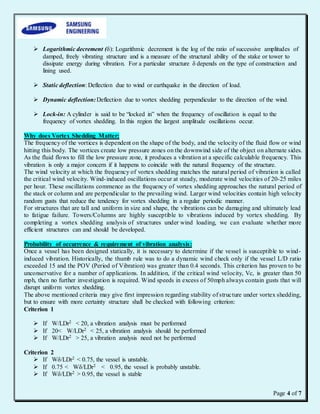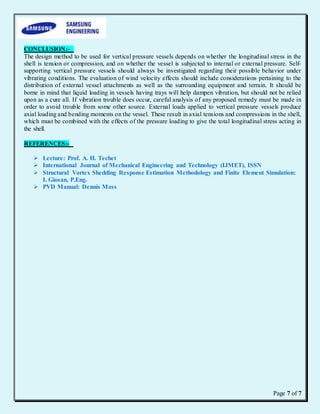This document summarizes research on vortex shedding and its effects on tall, cylindrical structures. It defines vortex shedding as alternating low pressure zones that form on the downwind side of a structure due to wind, causing vibrations. These vibrations can be damaging if they match the structure's natural frequency. The document outlines methods for analyzing the risk of vortex shedding, including calculating the vortex shedding frequency and comparing it to the structure's natural frequencies. It also discusses ways to address vortex shedding in design, such as adding strakes or changing the structure's geometry.




![Page 5 of 7
Limitations of the above criterion are that it should be restricted to cylindrical steel cantilevered structures
having fairly uniform distribution of non-stiffness masses and width Lc /L ratios less than 0.5, (D/L2) (10)4
less than eight, W/Ws ratio not exceeding six.
Where;
W :- Total weight of structure in lb
Ws :- Weight of structure excluding weight of parts which do not contribute to stiffness, lb
L :- Total length of structure, ft
Lc:- Total length of conical sections of structure, ft
D :- Average internal diameter of structure, ft
Dr: - Average internal diameter of top half of structure, ft
δ: - Logarithmic decrement
WF = Wδ/LDr2:- Damping factor
How to Calculate Vortex Shedding:-
Step 1: Determine the Vortex shedding Frequency
The vortex street frequency is calculated using the Reynolds number (which describes the fluid flow
characteristics) and the Strouhal number (which describes the oscillations of a fluid). The Reynolds number is
calculated using viscosity, density, flow velocity, and some geometry from the object in the fluid. It is
calculated over a range of flow speeds (or wind velocities). The Strouhal number is then calculated from those
Reynolds numbers, although for laminar flow situations a Strouhal of 0.2 is often used. The frequency of the
vortex street is then calculated using the Strouhal number, the width of the body, and the flow speed.
Re = VD /ν
Where:
Re = Reynolds number;
V= wind speed [m/s];
D= Structure diameter [m];
ν = kinematic viscosity [m2
/s].
Fluid characteristics’ in Reynolds number:-
Sub critical Range: Re < 3x105
Critical Range: 3x105 ≤ Re ≤ 3x106
Trans critical Range: Re > 3x106
Strouhal number:-
Subcritical (Re < 3x105): 0.18 (for circular cross section)
Supercritical and Trans critical (Re > 3x105): 0.25 (for circular cross section)
Vortex Shedding Frequency:-
fs = SV/ D
Where
fs = Vortex shedding frequency
S= Strouhal number
D= Structure diameter](https://image.slidesharecdn.com/b1b8f395-a67d-49bc-97ab-f86b243e7fb3-161026131320/85/Study-Report-Column-Vibration-5-320.jpg)

